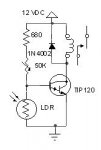krypton_john
Senior Member
Hi all,
I need to disable some 12VAC garden lights using a relay, when it is daylight. I don't think I need a PIC to do this and suspect it is a simple (for some) job for something like an LDR and an op-amp comparator? Or a photo transistor? to switch the relay. But it would need to be trimmable to set the level of daylight where the relay cuts out.
Any suggestions? I would crack open a garden light but I don't have one and I'd quite like to roll my own for the hell of it.
TIA,
JohnO
[EDIT] I guess the comparator is overkill and the LDR and a trimmer could be a simple voltage divider to turn on a transistor?
I need to disable some 12VAC garden lights using a relay, when it is daylight. I don't think I need a PIC to do this and suspect it is a simple (for some) job for something like an LDR and an op-amp comparator? Or a photo transistor? to switch the relay. But it would need to be trimmable to set the level of daylight where the relay cuts out.
Any suggestions? I would crack open a garden light but I don't have one and I'd quite like to roll my own for the hell of it.
TIA,
JohnO
[EDIT] I guess the comparator is overkill and the LDR and a trimmer could be a simple voltage divider to turn on a transistor?
Last edited:



